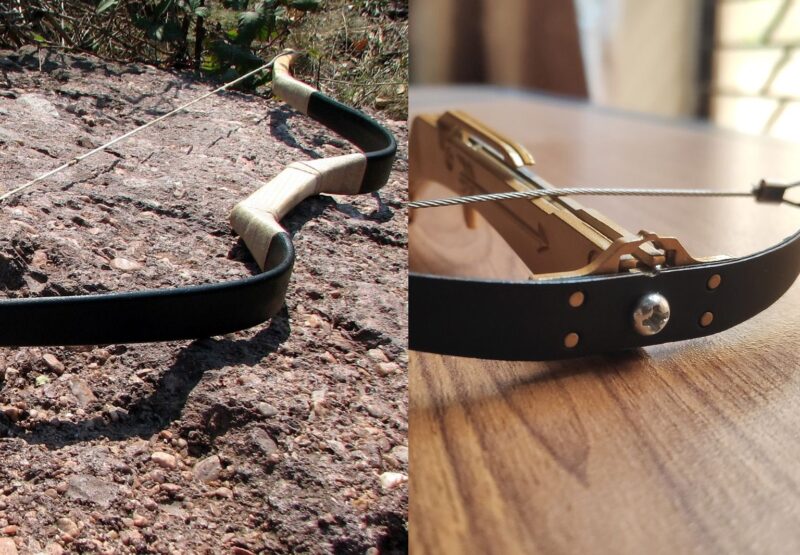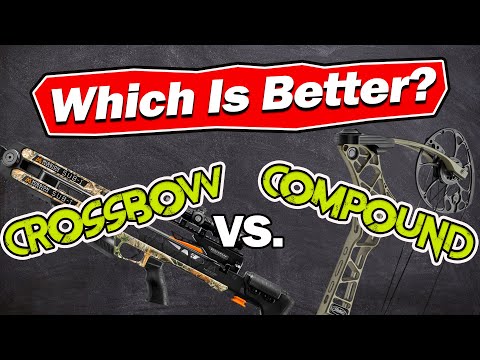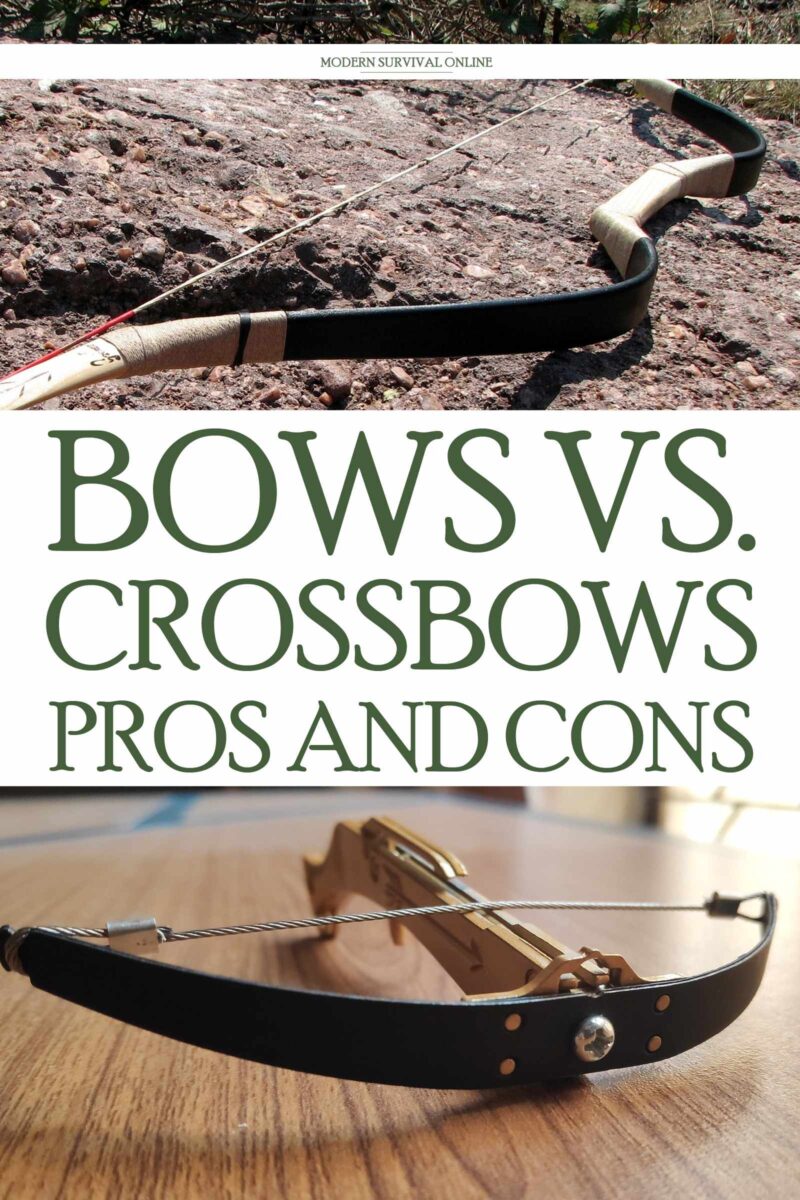When discussing weapon systems useful for putting meat in the freezer and warding off threats, the conversation among preppers naturally turns to guns much of the time.
However, other projectile weapons have special qualities to recommend them for the job, both during everyday life, and during an SHTF survival event. The two that most often spring to mind are bows and crossbows.

Any seasoned archer or hunter looking to get their feel during bow season has already heard the great debate come and go time and time again.
- Are bows or crossbows better?
- Is one truly superior for a seasoned archer?
- How about for a beginner?
- Could it be said that there is really one arrow shooter to rule them all?
The answer, like with so many other things, is it depends. Unless you are dealing with the very bottom of the barrel or the best the world has to offer the choice of any weapon system is a series of trade-offs, and learning how to assess those trade-offs against your own requirements ensures that you’ll walk away with a weapon capable of fulfilling your needs.
To help you accomplish this, this article will be providing you a rundown of the pros and cons typical of vertical compound bows and modern crossbows. But first, here are the main differences at a glance:
| Bow | Crossbow | |
|---|---|---|
| Ease of Use | ❌ harder to use | ☑ easier to use |
| Accuracy | ❌ inferior accuracy | ☑ superior accuracy |
| Power | ❌ less powerful | ☑ more powerful |
| Weight | ❌ heavier | ☑ lighter |
| Price | ☑ cheaper | ❌ more expensive |

Ease of Use
When it comes to ease of use and speed at building proficiency, there is no comparison. The crossbow is the definitive winner. Though both bow and crossbow are capable of similar ballistic feats at the end of the day, the crossbow turns what is usually a learning cliff into a gentle learning curve.
For users already experienced with firearms especially, it is easy to teach someone how to safely load, operate and attain good hits with a crossbow.
With a stock and trigger just like a rifle or shotgun, and a scope that can be zeroed similarly to those found on firearms, settling in and applying the fundamentals of marksmanship already ingrained in many folks makes getting good accurate hits with the crossbow a snap.
Contrast this with a modern compound bow, even one with an excellent release and siding system, users will still have to master stance, hold, draw, sighting, release and follow through with a weapon that requires considerably more physical investment than its cousin the crossbow or any firearm.
When you see a skilled archer repeatedly cutting the fletching off of preceding arrows in the target with a compound bow, it is a thing of wonder and beauty, but what you cannot see is the many hundreds and hundreds of hours of practice that they had to invest to reach that point.
An hour or two of training with a good crossbow can have shooters dropping bullseye hits at 20 or 30 yards.
On the other hand, drawing back the string of a crossbow is usually a fairly involved process whereas knocking and drawing the string of a compound bow is significantly simpler, if not easier. In short, a crossbow is much easier to shoot well, but more complicated to draw.
Accuracy
One of the most heated parts of the great bow versus crossbow debate is that of accuracy.
Seasoned archers utilize a compound bow are quick to point out that even the very best crossbows are not capable of achieving the repeatable level of accuracy that an expert bowman can with an appropriately set up, top of the line compound bow.
Rigorous testing in both competition and laboratory environments have borne out their assertion. This is not to say that a modern crossbow isn’t capable of excellent accuracy, however.
Additionally, raw mechanical accuracy, even in the hands of an extraordinarily proficient shooter, might not be something that is achievable under field conditions. The matter of practical accuracy must be considered.
Considering the crossbow does not require the archer to keep the bow drawn when refining their point of aim or waiting for an ideal shot to present itself concerning their quarry they are less fatiguing to use overall.
A fatigued archer typically experiences degraded accuracy. It takes hardly any effort at all to shoot a crossbow once the bow is drawn and the bolt or arrow loaded.
What’s more, crossbows utilize modern electoral optical sights or telescopic sights similar to those employed on firearms. When you can see better, you can shoot better and this naturally translates to superior accuracy under the same conditions with the same shooter.
At least, most of the time. The modern compound bows have seen extraordinary advancements in pin sights their efficacy in use still lags behind the sighting systems available for crossbows.
And here we must make our determination with a caveat: the best vertical compound bow in the hands of the best shooters may indeed be capable of better accuracy, but ultimately, a crossbow is more often capable of producing superior practical accuracy in field conditions.
Power
It has long been asserted that crossbows are patently more powerful than compound bows. This is most often not true today, though historical crossbows did often enjoy greater performance than a typical longbow of the era.
Considering power, the only metric that really matters when discussing bows is the velocity that a given arrow or bolt can achieve.
Virtually any quality crossbow today can push an arrow or bolt in excess of 300 ft per second with quite a few high end crossbows capable of meeting or breaking the 400 ft per second threshold that has long been the holy grail of modern bowmakers.
On the other hand, a modern, high end compound bow will usually attain 300 ft per second with little difficulty. For virtually any practical purpose, a bow capable of achieving the 300 ft per second benchmark is beyond adequate in nearly every situation.
A few years back now, makers of compound bows set out to finally equal or one up their crossbow competitors. The objective was a compound bow capable of pushing an arrow to 400 ft per second.
They achieved this benchmark, but the archers out here in the world capable of using such a bow with any consistency, to say nothing of repeated shots over time, are very few and far between, making this performance standard more of a novelty than anything else.
In the end, for most shooters across the widest spectrum of crossbows and compound bows, the two are roughly equal, though a crossbow makes extraordinary levels of power more accessible and more usable to more archers.
Noise
Compared to any firearm, even a suppressed one, both bows and crossbows are wondrously quiet. However, popular media has infused the imaginations of would be archers with the notion that crossbows are just as quiet as their compound bow counterparts. This is not true; at least it isn’t true when examining the vast majority of crossbows on the market.
There is not much to tell here. Upon release, a modern compound bow is far quieter than a crossbow.
Crossbows make a surprising clatter in operation, perhaps enough to spook an animal if one were to fire and miss. The animal, so alerted to your presence, will be halfway across the county before you were able to reload your crossbow.
The same situation and the same Miss but using a compound bow instead might not necessarily result and the animal being alerted to your presence.
This should also be considered from a self-defense standpoint in a serious, long-term SHTF event where one might have to defend themselves from hostile humans.
A near-distance shot with a compound bow might still go unnoticed by a human, but it is far from certain that they would not detect the release of an arrow from a crossbow.
Weight and Bulk
There is no contest here. The modern compound bow is far handier, lighter and less bulky than any crossbow.
Modern crossbows might be available in a variety of form factors, and an increasing amount even have a low profile or narrowed prod, but they are nowhere near as easy or as convenient to carry as a bow.
This is especially of concern when maneuvering in tight, dense foliage or other terrain or when climbing a ladder to get into a tree stand. The additional horizontal width of the crossbow means that your field of fire might be limited depending upon how tight the encroaching terrain is.
Carrying a compound bow requires hardly any effort at all, and most of them will easily fit into a scabbard or can be easily slung over one shoulder for mantling over an obstacle or climbing a ladder.
No matter how they are carried, in hand or slung across your back, crossbows tend to get tangled up or else bang into things while on the move.
Price
Today, crossbows and compound bows can both be very spendy, each easily setting you back several hundred dollars and even topping $1,000. That being said, when you are comparing apples to apples compound bows are simply less expensive than equivalent crossbows.
Shelling out $850 to $1,000 will get you a top of the line and nicely equipped compound bow will only land you near the upper middle of crossbows. Many of the best advertised crossbows easily top $1,000 and one’s fully equipped can set you back north of $1,500.
Value is always subjective, but if one is considering the raw performance of the tool compound bows are far kinder on your pocketbook.
However, if you are coming into archery generally you’ll be able to extract that better performance from a crossbow, and the time savings owing to its gentler learning curve may well justify its greater initial expense.
Safety
Much ado is made about the supposedly greater safety of compound bows. crossbows are even today demonized as being somehow less safe because they are easier to shoot, and many detractors latch on to the old whips that describe crossbows as having far greater power and greater range than compound bows, even when this is not true 99 times out of 100.
Ultimately, bows and crossbows are really equal when it comes to safety, though safety measures for both of them are different owing to their variations in mode of operation.
You can walk around with a bow in hand and an arrow knocked, but not drawn and need only worry about jabbing yourself with the exposed arrowhead. In all likelihood, the bow will not become accidentally drawn with the arrow knocked and then released.
On the other hand, a crossbow can be drawn with an arrow or bolt knocked and then kept in a ready-to-fire condition reliant only upon a pull of the trigger. This makes handling a loaded crossbow essentially identical to a firearm concerning safety measures.
When either is in a ready-to-fire condition both are capable of producing grievous or lethal wounds in the blink of an eye, just like a firearm, but the propensity of the crossbow to be kept in a ready-to-fire condition means that greater vigilance must be employed under those circumstances.
Practically, neither the crossbow nor the compound bow has an advantage when it comes to safety as it all boils down to user attentiveness and following best practices.
The Verdict
So which one is better? The bow or the crossbow?
The winner is… neither!
Like I said at the beginning, there is no clear-cut Superior technology for modern archers. In many categories, the mechanical performance gap between compound bows and crossbows is so narrow as to be virtually non-existent.
Like so many things, significant differences are only appreciable at extremes of human performance and technology.
Though it is entertaining and might even be educational to argue about the differences between Brand X and Brand y for bows or crossbows, the fundamentals of the technology are far less limiting than they were in years past.
As always, your requirements and more importantly your usage context should inform your gear selection. Said another way, it is the mission that drives the gear train.
If you are a proficient archer already well versed and shooting accurately with a compound bow, a crossbow probably has very little to recommend it. Similarly if you want to keep your load as light, lean and versatile is possible a bow is the way to go.
On the other hand, if you are new to archery and want to be engaging in your pursuits whatever they or without investing hours and hours in it seemingly fruitless practice, a crossbow might be just the shortcut you need.
Likewise, a crossbow could be the best option right out of the gate if you already have significant skill with a firearm, skills which will easily transfer to the stocked, optically sighted crossbow.
Don’t get caught up in any boastful or braggadocious arguments about what constitutes real archery or not. All that matters is getting hits on target, and the skilled practitioner chooses the best tool for the job according to its attributes, and definitely not for any reasons of ego or sentimentality.
Conclusion
Bows and crossbows have their own advantages and disadvantages. However, the differences in raw mechanical performance are not quite as great as most people think.
Even so, for new or seasoned archer alike one is likely going to be preferred over the other for any number of reasons. Take the time to read through our analysis above and you are sure to make a good choice.

via Modern Survival Online https://ift.tt/3qqWker
No comments:
Post a Comment